 The United States has a growing problem. The number of cases of the always fatal Chronic Wasting Disease (CWD) is steadily spreading among wild game (elk and deer) and has now been found in 30 states. In October 2020 it had been detected in 26 states, Dec. 2021 in 27 states, and as of April 2022 the US government reported it in 30 states!
The United States has a growing problem. The number of cases of the always fatal Chronic Wasting Disease (CWD) is steadily spreading among wild game (elk and deer) and has now been found in 30 states. In October 2020 it had been detected in 26 states, Dec. 2021 in 27 states, and as of April 2022 the US government reported it in 30 states!
Chronic wasting disease (CWD) is a prion disease similar to "mad-cow disease" (bovine spongiform encephalopathy) in cattle and Creutzfeldt-Jakob's disease in humans. There is no cure or treatment, and it is always fatal. While up to now CWD has only been found in deer and elk, the concern is that this disease will jump to humans, especially in people who eat contaminated meat.
Chronic wasting disease (CWD) should be of concern to all hunters or people who eat wild-caught game (deer, elk, moose, reindeer). No human cases have been detected, but health officials and the CDC warn people to avoid eating meat from CWD infected animals.
 Symptoms of the disease: In chronic wasting disease there is a long incubation period, followed by the brain become progressively like a sponge - riddled with holes, along with deterioration in brain function, behavioral changes, and eventually death. A horrible slow death. There are no treatments or vaccines.
Symptoms of the disease: In chronic wasting disease there is a long incubation period, followed by the brain become progressively like a sponge - riddled with holes, along with deterioration in brain function, behavioral changes, and eventually death. A horrible slow death. There are no treatments or vaccines.
How is it spread? Scientists believe CWD prions spread between animals through body fluids (e.g., feces, saliva, blood, or urine), either through direct contact or indirectly through environmental contamination of soil, food or water. Once introduced into an area or farm, the CWD prion (protein) is contagious within deer and elk populations and spreads.
Once CWD gets into the soil, it stays there for years, and so animals can contract it even after infected deer and elk have died. Yikes!
How do you get rid of it? Unfortunately, high heat, disinfectants, and radiation don't kill the CWD prions. Dr.Zabel at the Colorado State Univ. Prion Research Center suggested a few years ago that controlled burns (fires) of infected fields or areas could eliminate the prions left behind by infected animals (from animal mucus/saliva, urine, and feces, and decaying carcasses) on plants and soil.
This past year CWD was found in new regions, far from where it had been detected earlier. Some states have detected quite a few cases of CWD in wild deer over the years (e.g. Minnesota). It has also detected in Canada, Finland, Norway, South Korea, and Sweden.
A Chronic Wasting Disease Resource Center monitoring the situation and publishing information and research on its site is CIDRAP (Center for Infectious Disease and Policy).
Currently it's being monitored (usually voluntarily) - by hunters handing in deer heads (for the brain and lymph nodes) to state agencies to be checked for the disease.
Many are concerned with the role of captive hunt facilities/farms in spreading CWD - see map comparing CWD in wild caught game and captive facilities. This is also discussed in the following article.
From Civil Eats: Venison Was An Important Protein Source for Food Banks. Now It May Be Too Dangerous to Eat.
In the weeks before showing CWD symptoms, wild deer are “shedding infective materials like urine, feces, blood, saliva, and semen into the environment. Deer are very social so that is one way the disease is spreading,” says Kip Adams. He’s chief conservation officer for the National Deer Association (NDA), an organization that works in part to preserve wild deer and their habitats. However, Adams says many wildlife managers believe that the greatest culprit in spreading the disease is captive hunt facilities.
These are tracts of fenced land where people come to trophy hunt. What are known as shooter bucks are reared, with considerable trauma, in breeding farms that proliferate mostly in Texas. They are then transported across the country to hunting facilities from which they frequently escape; between 2004 and 2007, 437 animals escaped from facilities in Wisconsin alone. Infected escapees—but also penned animals that wander up to the fencing—can and do transmit CWD to wild deer populations. As a result, it’s rapidly spreading through some regions and moving into others.
